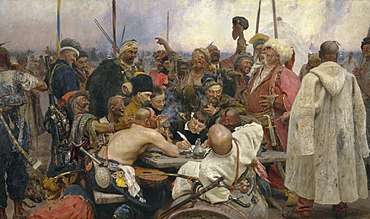History of Ukraine
Prehistoric Ukraine, as part of the Pontic steppe, has played an important role in Eurasian cultural contacts, including the spread of the Chalcolithic, the Bronze Age, Indo-European expansion and the domestication of the horse.[1][2][3]
Part of a series on the |
|---|
| History of Ukraine |
  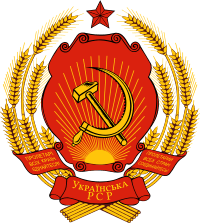 |
|
Early history
|
|
Modern history
|
|
Topics by history |
|
|
Part of Scythia in antiquity and settled by Getae, in the migration period, Ukraine is also the site of early Slavic expansion, and enters history proper with the establishment of the medieval state of Kievan Rus, which emerged as a powerful nation in the Middle Ages but disintegrated in the 12th century. After the middle of the 14th century, present-day Ukrainian territories came under the rule of three external powers:[4]
- the Golden Horde
- the Grand Duchy of Lithuania and the Kingdom of Poland – during the 15th century these lands came under the rule of the Crown of the Kingdom of Poland, then of the Polish–Lithuanian Commonwealth (from 1569)
- the Crimean Khanate (from the 15th century)
After a 1648 rebellion of the Cossacks against the Polish–Lithuanian Commonwealth, Hetman Bohdan Khmelnytsky agreed to the Treaty of Pereyaslav in January 1654. The exact nature of the relationship established by this treaty between Cossack Hetmanate and Russia remains a matter of scholarly controversy.[5] The agreement precipitated the Russo-Polish War (1654–67) also called The War for Ukraine. In consequence, by the Eternal Peace Treaty, signed in 1686, the eastern portion of Ukraine (east of the Dnieper River) were to come under Russian rule[6], 146,000 rubles were to be paid to Poland as compensation for the loss of the Right Bank of Ukraine[7] and the parties agreed not to sign a separate treaty with the Ottoman Empire.[8] The treaty was strongly opposed in Poland and was not ratified by the Sejm (parliament of the Polish–Lithuanian Commonwealth) until 1710.[9][10] The legal legitimacy of its ratification has been disputed.[11] According to Jacek Staszewski, the treaty was not confirmed by a resolution of the Sejm until the Convocation Sejm (1764).[12]
After the Partitions of Poland (1772–1795) and the Russian conquest of the Crimean Khanate, the Russian Empire and Habsburg Austria were in control of all the territories that constitute present day Ukraine for a hundred years.
A chaotic period of warfare ensued after the Russian Revolutions of 1917. The internationally recognised Ukrainian People's Republic emerged from its own civil war of 1917–1921. The Ukrainian–Soviet War (1917–1921) followed, in which the bolshevik Red Army established control in late 1919.[13] The Ukrainian Bolsheviks, who had defeated the national government in Kiev, established the Ukrainian Soviet Socialist Republic, which on 30 December 1922 became one of the founding republics of the Soviet Union. Initial Soviet policy on Ukrainian language and Ukrainian culture made Ukrainian the official language of administration and schools. Policy in the 1930s turned to russification. In 1932 and 1933, millions of people, mostly peasants, in Ukraine starved to death in a devastating famine, known as Holodomor. It is estimated by Encyclopædia Britannica that 6 to 8 million people died from hunger in the Soviet Union during this period, of whom 4 to 5 million were Ukrainians.[14] Nikita Khrushchev was appointed the head of the Ukrainian Communist Party in 1938.
After Nazi Germany and the Soviet Union invaded Poland in September 1939, the Ukrainian SSR's territory expanded westward. Axis armies occupied Ukraine from 1941 to 1944. During World War II the Ukrainian Insurgent Army fought for Ukrainian independence against both Germany and the Soviet Union. In 1945 the Ukrainian SSR became one of the founding members of the United Nations.[15] After the death of Stalin (1953), Khrushchev as head of the Communist Party of Soviet Union enabled a Ukrainian revival. Nevertheless, political repressions against poets, historians and other intellectuals continued, as in all other parts of the USSR. In 1954 the republic expanded to the south with the transfer of the Crimea.
Ukraine became independent again when the Soviet Union dissolved in 1991. This started a period of transition to a market economy, in which Ukraine suffered an eight-year recession.[16] Subsequently, however, the economy experienced a high increase in GDP growth. Ukraine was caught up in the worldwide economic crisis in 2008 and the economy plunged. GDP fell 20% from spring 2008 to spring 2009, then leveled off.[17]
The prolonged Ukrainian crisis began on 21 November 2013, when then-president Viktor Yanukovych suspended preparations for the implementation of an association agreement with the European Union. This decision resulted in mass protests by pro-Europeans – events which became known as the "Euromaidan". After months of such protests, the protesters ousted Yanukovych on 22 February 2014. Following his ousting, unrest enveloped the largely Russophone eastern and southern regions of Ukraine, from where Yanukovych had drawn most of his support. An invasion by Russia of the Ukrainian autonomous region of Crimea resulted in the annexation of Crimea by Russia on 18 March 2014. Subsequently, unrest in Donetsk and Luhansk oblasts of Ukraine evolved into a war between the post-revolutionary Ukrainian government and pro-Russian insurgents. The Ukrainian crisis also very negatively influenced the Ukrainian economy.
Prehistory
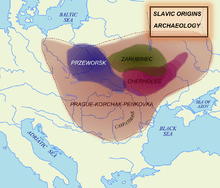
Settlement in Ukraine by members of the genus Homo has been documented into distant prehistory. The Neanderthals are associated with the Molodova archaeological sites (43,000–45,000 BC) which include a mammoth bone dwelling.[18][19] Gravettian settlements dating to 32,000 BC have been unearthed and studied in the Buran-Kaya cave site of the Crimean Mountains.[20][21]
Around 10,000 years ago the world's longest river[22] emptied glacier melted water through the Don and the Black Sea. From springs in Gobi it flowed along the Yenisei, which was then dammed by northern glaciers. Through the West Siberian Glacial Lake flowed about 10,000 km;[23] It was longer than any river known today.[24]

The late Neolithic times the Cucuteni-Trypillian Culture flourished from about 4500–3000 BC.[25] The Copper Age people of the Cucuteni-Trypillian Culture resided in the western part, and the Sredny Stog Culture further east, succeeded by the early Bronze Age Yamna ("Kurgan") culture of the steppes, and by the Catacomb culture in the 3rd millennium BC.
History
During the Iron Age, these were followed by the Dacians as well as nomadic peoples like the Cimmerians (archaeological Novocherkassk culture), Scythians and Sarmatians. The Scythian Kingdom existed here from 750–250 BC.[26] Along with ancient Greek colonies founded in the 6th century BC on the northeastern shore of the Black Sea, the colonies of Tyras, Olbia, Hermonassa, continued as Roman and Byzantine cities until the 6th century.
In the 3rd century AD, the Goths arrived in the lands of Ukraine around 250–375 AD, which they called Oium, corresponding to the archaeological Chernyakhov culture.[27] The Ostrogoths stayed in the area but came under the sway of the Huns from the 370s. North of the Ostrogothic kingdom was the Kiev culture, flourishing from the 2nd–5th centuries, when it was overrun by the Huns. After they helped defeat the Huns at the battle of Nedao in 454, the Ostrogoths were allowed by Romans to settle in Pannonia.
With the power vacuum created with the end of Hunnic and Gothic rule, Slavic tribes, possibly emerging from the remnants of the Kiev culture, began to expand over much of the territory that is now Ukraine during the 5th century, and beyond to the Balkans from the 6th century.
In the 7th century, the territory of modern Ukraine was the core of the state of the Bulgars (often referred to as Old Great Bulgaria) with its capital city of Phanagoria. At the end of the 7th century, most Bulgar tribes migrated in several directions and the remains of their state were absorbed by the Khazars, a semi-nomadic people from Central Asia.[27]
The Khazars founded the Khazar kingdom in the southeastern part of today's Europe, near the Caspian Sea and the Caucasus. The kingdom included western Kazakhstan, and parts of eastern Ukraine, Azerbaijan, southern Russia, and Crimea. Around 800 AD, the kingdom converted to Judaism.
Antes people
In the 5th and 6th centuries, the Antes Union was located in the territory of what is now Ukraine. The Antes were the ancestors of Ukrainians: White Croats, Severians, Polans, Drevlyans, Dulebes, Ulichians, and Tiverians. Migrations from Ukraine throughout the Balkans established many Southern Slavic nations. Northern migrations, reaching almost to the Lake Ilmen, led to the emergence of the Ilmen Slavs, Krivichs, and Radimichs, the groups ancestral to the Russians. After an Avar raid in 602 and the collapse of the Antes Union, most of these peoples survived as separate tribes until the beginning of the second millennium.[28]
Middle Ages
Kievan Rus'
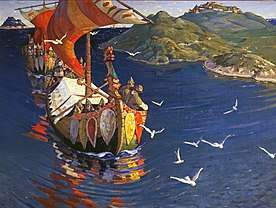
As Hrushevsky states, the city of Kiev was established during the time when area around the mid- and low-Dnipro was the part of the Khazar state. He derived that information from local legends because no written chronicles from that period are left.
In 882, Kiev was conquered from the Khazars by the Varangian noble Oleg who started the long period of rule of the Rurikid princes. During this time, several Slavic tribes were native to Ukraine, including the Polans, the Drevlyans, the Severians, the Ulichs, the Tiverians, the White Croats and the Dulebes. Situated on lucrative trade routes, Kiev among the Polanians quickly prospered as the center of the powerful Slavic state of Kievan Rus.
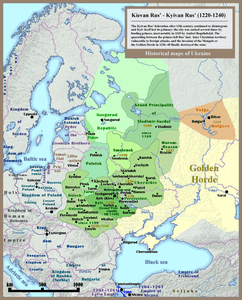
In 941 AD, the prince of Kiev invaded the Byzantine Empire but was defeated in the Rus'–Byzantine War (941).
In the 11th century, Kievan Rus' was, geographically, the largest state in Europe, becoming known in the rest of Europe as Ruthenia (the Latin name for Rus'), especially for western principalities of Rus' after the Mongol invasion. The name "Ukraine", meaning "in-land" or "native-land",[29] usually interpreted as "border-land", first appears in historical documents of the 12th century[30] and then on history maps of the 16th century period.[31]
This term seems to have been synonymous with the land of Rus' propria—the principalities of Kiev, Chernihiv and Pereiaslav. The term, "Greater Rus'" was used to apply to all the lands of entire Kievan Rus, including those that were not just Slavic, but also Uralic in the north-east portions of the state. Local regional subdivisions of Rus' appeared in the Slavic heartland, including, "Belarus'" (White Russia), "Chorna Rus'" (Black Russia) and "Cherven' Rus'" (Red Russia) in northwestern and western Ukraine.
Christianity

While Christianity had made headway into the territory of Ukraine before the first ecumenical council, the Council of Nicaea (325) (particularly along the Black Sea coast) and, in western Ukraine during the time of empire of Great Moravia, the formal governmental acceptance of Christianity in Rus' occurred in 988. The major promoter of the Christianization of Kievan Rus' was the Grand-Duke, Vladimir the Great (Volodymyr). His Christian interest was midwifed by his grandmother, Princess Olga. Later, an enduring part of the East-Slavic legal tradition was set down by the Kievan ruler, Yaroslav I, who promulgated the Russkaya Pravda (Truth of Rus') which endured through the Lithuanian period of Rus'.
Conflict among the various principalities of Rus', in spite of the efforts of Grand Prince Vladimir Monomakh, led to decline, beginning in the 12th century. In Rus' propria, the Kiev region, the nascent Rus' principalities of Halych and Volynia extended their rule. In the north, the name of Moscow appeared in the historical record in the principality of Suzdal, which gave rise to the nation of Russia. In the north-west, the principality of Polotsk increasingly asserted the autonomy of Belarus. Kiev was sacked by Vladimir principality (1169) in the power struggle between princes and later by Cumans and Mongol raiders in the 12th and 13th centuries, respectively. Subsequently, all principalities of present-day Ukraine acknowledged dependence upon the Mongols (1239–1240). In 1240, the Mongols sacked Kiev, and many people fled to other countries.
Five years after the fall of Kiev, Papal envoy Giovanni da Pian del Carpine wrote:
- "They destroyed cities and castles and killed men and Kiev, which is the greatest Russian city they besieged; and when they had besieged it a long while they took it and killed the people of the city. So when we went through that country we found countless human skulls and bones from the dead scattered over the field. Indeed it had been a very great and populous city and now is reduced almost to nothing. In fact there are hardly two hundred houses there now and the people are held in the strictest servitude."[32]
Galicia-Volhynia

A successor state to the Kievan Rus' on part of the territory of today's Ukraine was the principality of Galicia-Volhynia. Previously, Vladimir the Great had established the cities of Halych and Ladomir (later Volodimer) as regional capitals. This state was based upon the Dulebe, Tiverian and White Croat tribes.
The state was ruled by the descendants of Yaroslav the Wise and Vladimir Monomakh. For a brief period, the country was ruled by a Hungarian nobleman. Battles with the neighbouring states of Poland and Lithuania also occurred, as well as internecine warfare with the independent Ruthenian principality of Chernihiv to the east. At its greatest extension the territory of Galicia-Volhynia included later Wallachia/Bessarabia, thus reaching the shores of the Black Sea.
During this period (around 1200–1400), each principality was independent of the other for a period. The state of Halych-Volynia eventually became a vassal to the Mongolian Empire, but efforts to gain European support for opposition to the Mongols continued. This period marked the first "King of Rus'"; previously, the rulers of Rus' were termed, "Grand Dukes" or "Princes."
14th century
During the 14th century, Poland and Lithuania fought wars against the Mongol invaders, and eventually most of Ukraine passed to the rule of Poland and Lithuania. More particularly, the lands of Volynia in the north and north-west passed to the rule of Lithuanian princes, while the south-west passed to the control of Poland (Galicia). Also the Genoese founded some colonies in Crimean coasts until the Ottoman conquest in the 1470s.
Most of Ukraine bordered parts of Lithuania, and some say that the name, "Ukraine" comes from the local word for "border," although the name "Ukraine" was also used centuries earlier. Lithuania took control of the state of Volynia in northern and northwestern Ukraine, including the region around Kiev (Rus'), and the rulers of Lithuania then adopted the title of ruler of Rus'. Poland took control of the southeastern region. Following the union between Poland and Lithuania, Poles, Germans, Lithuanians and Jews migrated to the region. The 15th-century decline of the Golden Horde enabled the foundation of the Crimean Khanate, which occupied present-day Black Sea shores and southern steppes of Ukraine. Until the late 18th century, the Crimean Khanate maintained a massive slave trade with the Ottoman Empire and the Middle East,[33] exporting about 2 million slaves from Russia and Ukraine over the period 1500–1700.[34] It remained a vassal state of the Ottoman Empire until 1774, when it was finally dissolved by the Russian Empire in 1783.
Early modern period
Polish–Lithuanian Commonwealth

After the Union of Lublin in 1569 and the formation of the Polish–Lithuanian Commonwealth Ukraine fell under Polish administration, becoming part of the Crown of the Kingdom of Poland. The period immediately following the creation of the Commonwealth saw a huge revitalisation in colonisation efforts. Many new cities and villages were founded. Links between different Ukrainian regions, such as Galicia and Volyn were greatly extended.[35]
New schools spread the ideas of the Renaissance; Polish peasants arrived in great numbers and quickly became mixed with the local population; during this time, most of Ukrainian nobles became polonised and converted to Catholicism, and while most Ruthenian-speaking peasants remained within the Eastern Orthodox Church, social tension rose.
Ruthenian peasants who fled efforts to force them into serfdom came to be known as Cossacks and earned a reputation for their fierce martial spirit. Some Cossacks were enlisted by the Commonwealth as soldiers to protect the southeastern borders of Commonwealth from Tatars or took part in campaigns abroad (like Petro Konashevych-Sahaidachny in the battle of Khotyn 1621). Cossack units were also active in wars between the Polish–Lithuanian Commonwealth and Tsardom of Russia. Despite the Cossack's military usefulness, the Commonwealth, dominated by its nobility, refused to grant them any significant autonomy, instead attempting to turn most of the Cossack population into serfs. This led to an increasing number of Cossack rebellions aimed at the Commonwealth.
Cossack era
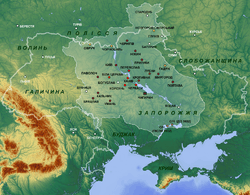
The 1648 Ukrainian Cossack (Kozak) rebellion or Khmelnytsky Uprising, which started an era known as the Ruin (in Polish history as The Deluge), undermined the foundations and stability of the Commonwealth. The nascent Cossack state, the Cossack Hetmanate,[36] usually viewed as precursor of Ukraine,[36] found itself in a three-sided military and diplomatic rivalry with the Ottoman Turks, who controlled the Tatars to the south, the Commonwealth of Poland and Lithuania, and the Tsardom of Muscovy to the East.
The Zaporizhian Host, in order to leave the Polish–Lithuanian Commonwealth, sought a treaty of protection with Russia in 1654.[36] This agreement was known as the Treaty of Pereyaslav.[36] Commonwealth authorities then sought compromise with the Ukrainian Cossack state by signing the Treaty of Hadiach in 1658, but—after thirteen years of incessant warfare—the agreement was later superseded by 1667 Polish–Russian Treaty of Andrusovo, which divided Ukrainian territory between the Commonwealth and Russia. Under Russia, the Cossacks initially retained official autonomy in the Hetmanate.[36] For a time, they also maintained a semi-independent republic in Zaporozhia, and a colony on the Russian frontier in Sloboda Ukraine.
Russian Empire and Austria-Hungary
During subsequent decades, Tsarist rule over central Ukraine gradually replaced 'protection'. Sporadic Cossack uprisings were now aimed at the Russian authorities, but eventually petered out by the late 18th century, following the destruction of entire Cossack hosts. After the Partitions of Poland in 1772, 1793 and 1795, the extreme west of Ukraine fell under the control of the Austrians, with the rest becoming a part of the Russian Empire. As a result of Russo-Turkish Wars the Ottoman Empire's control receded from south-central Ukraine, while the rule of Hungary over the Transcarpathian region continued. Ukrainian writers and intellectuals were inspired by the nationalistic spirit stirring other European peoples existing under other imperial governments and became determined to revive the Ukrainian linguistic and cultural traditions and re-establish a Ukrainian nation-state, a movement that became known as Ukrainophilism.
Russia, fearing separatism, imposed strict limits on attempts to elevate the Ukrainian language and culture, even banning its use and study. The Russophile policies of Russification and Panslavism led to an exodus of a number of Ukrainian intellectuals into Western Ukraine. However, many Ukrainians accepted their fate in the Russian Empire and some were to achieve a great success there. Many Russian writers, composers, painters and architects of the 19th century were of Ukrainian descent. Probably the most notable were Nikolai Gogol, one of the greatest writers in the history of Russian literature, and Pyotr Ilyich Tchaikovsky, one of the greatest composers in the history of Russian music, whose father came of Ukrainian Cossack stock.
The fate of the Ukrainians was far different under the Austrian Empire where they found themselves in the pawn position of the Russian-Austrian power struggle for the Central and Southern Europe. Unlike in Russia, most of the elite that ruled Galicia were of Austrian or Polish descent, with the Ruthenians being almost exclusively kept in peasantry. During the 19th century, Russophilia was a common occurrence among the Slavic population, but the mass exodus of Ukrainian intellectuals escaping from Russian repression in Eastern Ukraine, as well as the intervention of Austrian authorities, caused the movement to be replaced by Ukrainophilia, which would then cross-over into the Russian Empire. With the start of World War I, all those supporting Russia were rounded up by Austrian forces and held in a concentration camp at Talerhof where many died.
Modern history

17th and 18th Century Ukraine
Ukraine emerges as the concept of a nation, and the Ukrainians as a nationality, with the Ukrainian National Revival in the mid-18th century, in the wake of the peasant revolt of 1768/69 and the eventual partition of the Polish–Lithuanian Commonwealth. Galicia fell to the Austrian Empire, and the rest of Ukraine to the Russian Empire.
While right-bank Ukraine belonged to the Polish–Lithuanian Commonwealth until late 1793, left-bank Ukraine had been incorporated into Tsardom of Russia in 1667 (under the Treaty of Andrusovo). In 1672, Podolia was occupied by the Turkish Ottoman Empire, while Kiev and Braclav came under the control of Hetman Petro Doroshenko until 1681, when they were also captured by the Turks but in 1699 the Treaty of Karlowitz returned those lands to the Commonwealth.
Most of Ukraine fell to the Russian Empire under the reign of Catherine the Great; in 1793 right-bank Ukraine was annexed by Russia in the Second Partition of Poland.[37]
Ukrainian writers and intellectuals were inspired by the nationalistic spirit stirring other European peoples existing under other imperial governments. Russia, fearing separatism, imposed strict limits on attempts to elevate the Ukrainian language and culture, even banning its use and study. The Russophile policies of Russification and Panslavism led to an exodus of a number some Ukrainian intellectuals into Western Ukraine, while others embraced a Pan-Slavic or Russian identity. This led to many of the great Russian authors and composers of the 19th century being of Ukrainian origin (notably Nikolai Gogol and Pyotr Ilyich Tchaikovsky).
Ukraine and the World Wars
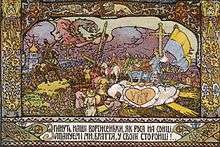
.jpg)

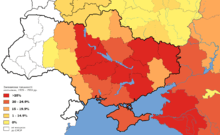
Ukraine, which included Crimea, the Kuban, and portions of Don Cossack lands with large Ukrainian populations (along with ethnic Russians, and Jews), tried to break free from Russia after the February 1917 revolution in St. Petersburg. Historian Paul Kubicek states:
- Between 1917 and 1920, several entities that aspired to be independent Ukrainian states came into existence. This period, however, was extremely chaotic, characterized by revolution, international and civil war, and lack of strong central authority. Many factions competed for power in the area that is today’s Ukraine, and not all groups desired a separate Ukrainian state. Ultimately, Ukrainian independence was short-lived, as most Ukrainian lands were incorporated into the Soviet Union and the remainder, in western Ukraine, was divided among Poland, Czechoslovakia, and Romania.[38]
Canadian scholar Orest Subtelny provides a context from the long span of European history:
- In 1919 total chaos engulfed Ukraine. Indeed, in the modern history of Europe no country experienced such complete anarchy, bitter civil strife, and total collapse of authority as did Ukraine at this time. Six different armies-– those of the Ukrainians, the Bolsheviks, the Whites, the Entente [French], the Poles and the anarchists – operated on its territory. Kiev changed hands five times in less than a year. Cities and regions were cut off from each other by the numerous fronts. Communications with the outside world broke down almost completely. The starving cities emptied as people moved into the countryside in their search for food.[39]
The Ukrainian War of Independence of 1917 to 1921 produced the Free Territory of Ukraine, Ukrainian Soviet Socialist Republic (in 1919 merged from the Ukrainian People's Republic and West Ukrainian People's Republic) which was quickly subsumed in the Soviet Union. Galicia, South Bessarabia, Northern Bukovina, and Carpathian Ruthenia were added as a result of the Molotov–Ribbentrop Pact in 1939 and the Soviet victory over Germany in the Second World War, 1939–45.
The Soviet famine of 1932–33, now known as the Holodomor, left millions dead in the Soviet Union, the majority of them Ukrainians not only in Ukraine but also in Kuban and former Don Cossack lands.[40][41]
The Second World War began in September 1939, when Hitler and Stalin invaded Poland, the Soviet Union taking most of Western Ukraine. Nazi Germany with its allies invaded the Soviet Union in 1941. Some Ukrainians initially regarded the Wehrmacht soldiers as liberators from Soviet rule, while others formed a partisan movement. Some elements of the Ukrainian nationalist underground formed a Ukrainian Insurgent Army that fought both Soviet forces and the Nazi. Others collaborated with the Germans. Some 1.5 million Jews were murdered by the Nazis during their occupation.[42] In Volhynia, Ukrainian fighters committed a massacre against up to 100,000 Polish civilians.[43] Residual small groups of the UPA-partizans acted near the Polish and Soviet border as long as to the 1950s.[44]
After World War II some amendments to the Constitution of the Ukrainian SSR were accepted, which allowed it to act as a separate subject of international law in some cases and to a certain extent, remaining a part of the Soviet Union at the same time. In particular, these amendments allowed the Ukrainian SSR to become one of founding members of the United Nations (UN) together with the Soviet Union and the Byelorussian SSR. This was part of a deal with the United States to ensure a degree of balance in the General Assembly, which, the USSR opined, was unbalanced in favor of the Western Bloc. In its capacity as a member of the UN, the Ukrainian SSR was an elected member of the United Nations Security Council in 1948–1949 and 1984–1985. The Crimean Oblast was transferred from the RSFSR to the Ukrainian SSR in 1954.
Independence
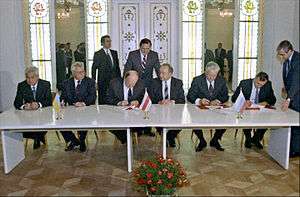
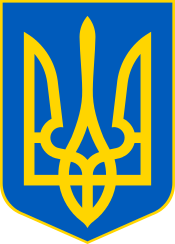

With the collapse of the Soviet Union in 1991, Ukraine became an independent state, formalised with a referendum in December 1991.
On 21 January 1990, over 300,000 Ukrainians[45] organized a human chain for Ukrainian independence between Kiev and Lviv. Ukraine officially declared itself an independent country on 24 August 1991, when the communist Supreme Soviet (parliament) of Ukraine proclaimed that Ukraine would no longer follow the laws of USSR and only the laws of the Ukrainian SSR, de facto declaring Ukraine's independence from the Soviet Union. On 1 December, voters approved a referendum formalizing independence from the Soviet Union. Over 90% of Ukrainian citizens voted for independence, with majorities in every region, including 56% in Crimea. The Soviet Union formally ceased to exist on 26 December, when the presidents of Ukraine, Belarus and Russia (the founding members of the USSR) met in Białowieża Forest to formally dissolve the Union in accordance with the Soviet Constitution. With this Ukraine's independence was formalized de jure and recognized by the international community.
(Also) on 1 December 1991 Ukrainian voters first presidential election elected Leonid Kravchuk.[46] During his presidency the Ukrainian economy shrank by more than 10% per year (in 1994 by more than 20%).[46]
The presidency (1994–2005) of the 2nd President of Ukraine Leonid Kuchma was surrounded by numerous corruption scandals and the lessening of media freedoms; including the Cassette Scandal.[46][47] During Kuchma's presidency, the economy recovered, with GDP growth at around 10% a year in his last years in office.[46]
In 2004, Kuchma announced that he would not run for re-election. Two major candidates emerged in the 2004 presidential election. Viktor Yanukovych, the incumbent Prime Minister, supported by both Kuchma and by the Russian Federation, wanted closer ties with Russia. The main opposition candidate, Viktor Yushchenko, called for Ukraine to turn its attention westward and aim to eventually join the EU. In the runoff election, Yanukovych officially won by a narrow margin, but Yushchenko and his supporters alleged that vote rigging and intimidation cost him many votes, especially in eastern Ukraine. A political crisis erupted after the opposition started massive street protests in Kiev and other cities ("Orange Revolution"), and the Supreme Court of Ukraine ordered the election results null and void. A second runoff found Viktor Yushchenko the winner. Five days later, Yanukovych resigned from office and his cabinet was dismissed on 5 January 2005.
During the Yushchenko term, relations between Russia and Ukraine often appeared strained as Yushchenko looked towards improved relations with the European Union and less toward Russia.[48] In 2005, a highly publicized dispute over natural gas prices with Russia caused shortages in many European countries that were reliant on Ukraine as a transit country.[49] A compromise was reached in January 2006.[49]
By the time of the presidential election of 2010, Yushchenko and Yulia Tymoshenko — allies during the Orange Revolution — had become bitter enemies.[46] Tymoshenko ran for president against both Yushchenko and Viktor Yanukovych, creating a three-way race. Yushchenko, whose popularity had plummeted,[48] persisted in running, and many pro-Orange voters stayed home.[50] In the second round of the election Yanukovych won the run-off ballot with 48% to Tymoshenko's 45%.
During his presidency (2010–2014) Yanukovych and his Party of Regions were accused of trying to create a "controlled democracy" in Ukraine and of trying to destroy the main opposition party Bloc Yulia Tymoshenko, but both have denied these charges.[51] One frequently cited example of Yankukovych's attempts to centralise power was the 2011 sentencing of Yulia Tymoshenko, which has been condemned by Western governments as potentially being politically motivated.[52]
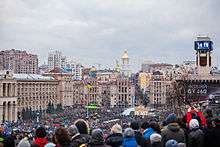
In November 2013, President Yanukovych did not sign the Ukraine–European Union Association Agreement and instead pursued closer ties with Russia.[53][54] This move sparked protests on the streets of Kiev and, ultimately, the 2014 Ukrainian revolution. Protesters set up camps in Kiev's Maidan Nezalezhnosti (Independence Square),[55] and in December 2013 and January 2014 protesters started taking over various government buildings, first in Kiev and, later, in Western Ukraine.[56] Battles between protesters and police resulted in about 80 deaths in February 2014.[57][58]
Following the violence the Ukrainian parliament on 22 February voted to remove Yanukovych from power (on the grounds that his whereabouts were unknown and he thus could not fulfil his duties), and to free Yulia Tymoshenko from prison. The same day Yanukovych supporter Volodymyr Rybak resigned as speaker of the Parliament, and was replaced by Tymoshenko loyalist Oleksandr Turchynov, who was subsequently installed as interim President.[59] Yanukovych had fled Kiev, and subsequently gave a press conference in the Russian city of Rostov-on-Don.[60]
In March 2014, the Annexation of Crimea by the Russian Federation occurred. Though official results of a referendum on reunification with Russia were reported as showing a large majority in favor of the proposition, the vote was organized under Russian military occupation and was denounced by the European Union and the United States as illegal.[61]
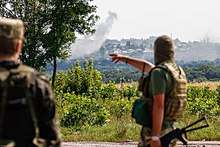
The Crimean crisis was followed by pro-Russian unrest in east Ukraine and south Ukraine.[62] In April 2014 Ukrainian separatists self-proclaimed the Donetsk People's Republic and Lugansk People's Republic and held referendums on 11 May 2014; the separatists claimed nearly 90% voted in favor of independence.[63][62] Later in April 2014, fighting between the Ukrainian army and pro-Ukrainian volunteer battalions on one side, and forces supporting the Donetsk and Lugansk People's Republics on the other side, escalated into the War in Donbass.[62][64] By December 2014 more than 6,400 people had died in this conflict and according to United Nations figures it led to over half a million people becoming internally displaced within Ukraine and two hundred thousand refugees to flee to (mostly) Russia and other neighboring countries.[65][66][67][68] During the same period, political (including adoption of the law on lustration and the law on decommunization) and economic reforms started.[69] On 25 May 2014, Petro Poroshenko was elected president in the first round of the presidential election.
By the second half of 2015 independent observers noted that reforms in Ukraine had considerably slowed down, corruption did not subside, and the economy of Ukraine was still in a deep crisis.[69][70][71][72]
By December 2015, more than 9,100 people had died (largely civilians) in the War in Donbass, according to United Nations figures.[73]
On 21 April 2019, Volodymyr Zelensky was elected president in the second round of the presidential election.
National historiography
The scholarly study of Ukraine's history emerged from romantic impulses in the late 19th century. The outstanding leaders were Volodymyr Antonovych (1834–1908), based in Kiev, and his student Mykhailo Hrushevsky (1866–1934).[74] For the first time full-scale scholarly studies based on archival sources, modern research techniques, and modern historical theories became possible. However, the demands of government officials—especially Soviet, but also Czarists and Polish—made it difficult to disseminate ideas that ran counter to the central government. Therefore, exile schools of historians emerged in central Europe and Canada after 1920.[75]
Strikingly different interpretations of the medieval state of Kievan Rus' appear in the four schools of historiography within Ukraine: Russophile, Sovietophile, Eastern Slavic, and Ukrainophile. The Sovietophile and Russophile schools have become marginalized in independent Ukraine, with the Ukrainophile school being dominant in the early 21st century. The Ukrainophile school promotes an identity that is mutually exclusive of Russia. It has come to dominate the nation's educational system, security forces, and national symbols and monuments, although it has been dismissed as nationalist by Western historians. The East Slavic school, an eclectic compromise between Ukrainophiles and Russophilism, has a weaker ideological and symbolic base, although it is preferred by Ukraine's centrist former elites.[76]
Many historians in recent years have sought alternatives to national histories, and Ukrainian history invited approaches that looked beyond a national paradigm. Multiethnic history recognises the numerous peoples in Ukraine; transnational history portrays Ukraine as a border zone for various empires; and area studies categorises Ukraine as part of Eurasia, or more often as part of East-Central Europe. Plokhy (2007) argues that looking beyond the country's national history has made possible a richer understanding of Ukraine, its people, and the surrounding regions.[77]
After 1991, historical memory was a powerful tool in the political mobilization and legitimation of the post-Soviet Ukrainian state, as well as the division of selectively used memory along the lines of the political division of Ukrainian society. Ukraine did not experience the restorationist paradigm typical of some other post-Soviet nations, including the Baltic states, although the multifaceted history of independence, the Orthodox Church in Ukraine, Soviet-era repressions, mass famine, and World War II collaboration were used to provide a different constitutive frame for the new Ukrainian nation. The politics of identity (which includes the production of history textbooks and the authorization of commemorative practices) has remained fragmented and tailored to reflect the ideological anxieties and concerns of individual regions of Ukraine.[78]
Canadian historiography on Ukraine
Inside Ukraine 20th century historians were strictly limited in the range of models and topics they could cover, with Moscow insisting on an official Marxist approach. However émigré Ukrainians in Canada developed an independent scholarship that ignored Marxism, and shared the Western tendencies in historiography.[79] George W. Simpson and Orest Subtelny were leaders promoting Ukrainian studies in Canadian academe.[80] The lack of independence in Ukraine meant that traditional historiographical emphases on diplomacy and politics were handicapped. The flourishing of social history after 1960 opened many new approaches for researchers in Canada; Subtelny used the modernization model. Later historiographical trends were quickly adapted to the Ukrainian evidence, with special focus on Ukrainian nationalism. The new cultural history, post-colonial studies, and the "linguistic turn" augmenting, if not replacing social history, allowed for multiple angles of approach. By 1991, historians in Canada had freely explored a wide range of approaches regarding the emergence of a national identity. After independence, a high priority in Canada was assisting in the freeing of Ukrainian scholarship from Soviet-Marxist orthodoxy—which downplayed Ukrainian nationalism and insisted that true Ukrainians were always trying to reunite with Russia. Revolt against Moscow meant freedom from an orthodoxy never was well-suited to Ukrainian developments. Inside Ukraine scholars welcomed the "national paradigm" that Canadian historians had helped develop. Since 1991, the study of Ukrainian nation building became an increasingly global and collaborative enterprise, with scholars from Ukraine studying and working in Canada, and with conferences on related topics attracting scholars from around the world.[81]
See also
| Wikimedia Commons has media related to Historical maps of Ukraine. |
References
- Matossian Shaping World History p. 43
- "What We Theorize – When and Where Did Domestication Occur". International Museum of the Horse. Retrieved 12 December 2010.(Citation does not exist anymore)
- "Horsey-aeology, Binary Black Holes, Tracking Red Tides, Fish Re-evolution, Walk Like a Man, Fact or Fiction". Quirks and Quarks Podcast with Bob Macdonald. CBC Radio. 7 March 2009. Retrieved 18 September 2010.(Link does not exist anymore)
- "Ukraine :: History – Britannica Online Encyclopedia". Britannica.com. Retrieved 31 October 2011.
- Kroll, Piotr (2008). Od ugody hadziackiej do Cudnowa. Kozaczyzna między Rzecząpospolitą a Moskwą w latach 1658-1660. doi:10.31338/uw.9788323518808. ISBN 9788323518808.
- Riasanovsky, Nicholas V. (1963). A History of Russia. Oxford University Press. p. 199.
- Jerzy Jan Lerski; Piotr Wróbel; Richard J. Kozicki (1996). Historical dictionary of Poland, 966-1945. Greenwood Publishing Group. p. 183. ISBN 978-0-313-26007-0.
- Jerzy Jan Lerski; Piotr Wróbel; Richard J. Kozicki (1996). Historical dictionary of Poland, 966-1945. Greenwood Publishing Group. p. 183. ISBN 978-0-313-26007-0.
- Jerzy Jan Lerski; Piotr Wróbel; Richard J. Kozicki (1996). Historical dictionary of Poland, 966-1945. Greenwood Publishing Group. p. 183. ISBN 978-0-313-26007-0.
- Norman Davies (1982). God's Playground, a History of Poland: The origins to 1795. Columbia University Press. p. 406. ISBN 978-0-231-05351-8.
- Eugeniusz Romer, O wschodniej granicy Polski z przed 1772 r., w: Księga Pamiątkowa ku czci Oswalda Balzera, t. II, Lwów 1925, s. [355].
- Jacek Staszewski, August II Mocny, Wrocław 1998, p. 100.
- Riasanovsky (1963), p. 537.
- "Ukraine – The famine of 1932–33". Encyclopædia Britannica. Retrieved 26 June 2008.
- "Activities of the Member States – Ukraine". United Nations. Retrieved 17 January 2011.
- "Macroeconomic Indicators". National Bank of Ukraine. Archived from the original on 21 October 2007.
- Inozmi, "Ukraine – macroeconomic economic situation". June 2009.
- Gray, Richard (18 December 2011). "Neanderthals built homes with mammoth bones". Telegraph.co.uk.
- Molodova I and V (Ukraine)
- Prat, Sandrine; Péan, Stéphane C.; Crépin, Laurent; Drucker, Dorothée G.; Puaud, Simon J.; Valladas, Hélène; Lázničková-Galetová, Martina; van der Plicht, Johannes; et al. (17 June 2011). "The Oldest Anatomically Modern Humans from Far Southeast Europe: Direct Dating, Culture and Behavior". plosone. doi:10.1371/journal.pone.0020834.
- Carpenter, Jennifer (20 June 2011). "Early human fossils unearthed in Ukraine". BBC. Retrieved 21 June 2011.
- Suhoi Don (stux)
- Mangerud, J. et al. (2004). Ice-dammed lakes and rerouting of the drainage of northern Eurasia during the Last Glaciation. Quaternary Science Reviews 23 (2004), pp. 1313–1332. (accessed 30 November 2006)
- "Azerbaijan: Land of Fire and Flood – Ancient Mariners and a Deluged Landscape - Graham Hancock Official Website".
- "Trypillian Civilization 5,508 – 2,750 BC". The Trypillia-USA-Project. Archived from the original on 12 December 2007. Retrieved 16 December 2007.
- "Scythian". Encyclopædia Britannica. Retrieved 12 September 2007.
- Magocsi, Paul Robert (1996). A History of Ukraine. Toronto: University of Toronto Press. p. 27. ISBN 0-8020-0830-5.
- М. Грушевський – "Історія України". Том І, розділ IV, Велике слов'янське розселення: Історія Антів, їх походи, війна з Словянами, боротьба з Аварами, останні звістки, про Антів.
- uk:Україна (назва)
- Name of Ukraine
- Історичні назви українських територій
- "Ukrainian Tribal Divisions and Ethnographic Groups". Home.swipnet.se. Archived from the original on 18 March 2009. Retrieved 30 January 2011.
- Brian Glyn Williams (2013). "The Sultan's Raiders: The Military Role of the Crimean Tatars in the Ottoman Empire" (PDF). The Jamestown Foundation. p. 27. Archived from the original (PDF) on 21 October 2013.
- Darjusz Kołodziejczyk, as reported by Mikhail Kizilov (2007). "Slaves, Money Lenders, and Prisoner Guards:The Jews and the Trade in Slaves and Captivesin the Crimean Khanate". The Journal of Jewish Studies: 2.
- Yakovenko, N. Ukrainian nobility from the end of 14th century to the mid of 17th century. Ed.2. Krytyka. Kiev 2008. ISBN 966-8978-14-5.
- Ukraine: Birth of a Modern Nation by Serhy Yekelchyk, Oxford University Press (2007), ISBN 978-0-19-530546-3
- Orest Subtelny; Ukraine: A History; University of Toronto Press; 2000. ISBN 0-8020-8390-0. pp 117-145-146-148
- Paul Kubicek, The History of Ukraine (2008) p 79
- Orest Subtelny (2000). Ukraine: A History. U of Toronto Press. p. 359. ISBN 9780802083906.
- "The famine of 1932–33", Encyclopædia Britannica. Quote: "The Great Famine (Holodomor) of 1932–33 – a man-made demographic catastrophe unprecedented in peacetime. Of the estimated six to eight million people who died in the Soviet Union, about four to five million were Ukrainians... Its deliberate nature is underscored by the fact that no physical basis for famine existed in Ukraine... Soviet authorities set requisition quotas for Ukraine at an impossibly high level. Brigades of special agents were dispatched to Ukraine to assist in procurement, and homes were routinely searched and foodstuffs confiscated... The rural population was left with insufficient food to feed itself."
- Anne Applebaum. Red Famine: Stalin's War on Ukraine (2017).
- NBC: The Messy, Bloody History of Ukraine |author=Iain King |date=2019-09-28
- "Mariusz Zajączkowski: 1943 Volhynia massacre". Archived from the original on 13 April 2014. Retrieved 9 April 2014.
- Kyiv Post: Ukrainian Insurgent Army: Myths and facts
- Subtelny, Orest (2000). Ukraine: A History. University of Toronto Press. p. 576. ISBN 0-8020-8390-0.
- Ukraine country profile – Overview, BBC News
- Adrian Karatnycky, "Ukraine's Orange Revolution," Foreign Affairs, Vol. 84, No. 2 (Mar. – Apr. 2005), pp. 35–52 in JSTOR
- Profile: Viktor Yushchenko, BBC News
- Ukraine country profile – Overview 2012, BBC News
- Ukraine's New President: Is the Orange Revolution Over?, Time.com (11 February 2010)
- Ukraine right-wing politics: is the genie out of the bottle?, openDemocracy.net (3 January 2011)
Ukraine viewpoint: Novelist Andrey Kurkov, BBC News (13 January 2011)
Ukraine ex-PM Tymoshenko charged with misusing funds, BBC News (20 December 2010)
The Party of Regions monopolises power in Ukraine, Centre for Eastern Studies (29 September 2010)
Ukraine launches battle against corruption, BBC News (18 January 2011)
Ukrainians' long wait for prosperity, BBC News (18 October 2010)
Ukraine:Journalists Face Uncertain Future, Pulitzer Center on Crisis Reporting (27 October 2010)
"Our Ukraine comes to defense of Tymoshenko, Lutsenko, Didenko, Makarenko in statement". Interfax-Ukraine. 25 May 2011. Archived from the original on 3 June 2012. - "Archived copy". Archived from the original on 4 March 2016. Retrieved 8 February 2016.CS1 maint: archived copy as title (link) US Embassy, Kiev, (24 September 2011)
https://www.bbc.co.uk/news/world-europe-14459446 BBC News, (24 September 2011) - Why is Ukraine in turmoil?, BBC News (21 February 2014)
- "Ukraine 'still wants to sign EU deal' | News | al Jazeera".
- Ukraine crisis: Police storm main Kiev 'Maidan' protest camp, BBC News (19 February 2014)
- Ukraine protests timeline, BBC News (21 February 2014)
- Sandford Daniel (19 February 2014). "Ukraine crisis: Renewed Kiev assault on protesters". BBC News. Retrieved 19 February 2014.
- "Ukraine crisis: Yanukovych announces 'peace deal'". BBC News. 21 February 2014. Retrieved 21 February 2014.
- "Profile: Olexander Turchynov". BBC News. 23 February 2014. Retrieved 25 February 2014.
- Taylor, Charles (28 February 2014). "Profile: Ukraine's ousted President Viktor Yanukovych". BBC News. Retrieved 4 May 2014.
- "Crimea referendum: Voters 'back Russia union'". BBC News. 10 March 2014. Retrieved 4 May 2014.
- Ukraine crisis timeline, BBC News
- Putin Tells Separatists In Ukraine To Postpone May 11 Referendum, NPR (7 May 2014)
"Ukraine rebels hold referendums in Donetsk and Luhansk". BBC News. 11 May 2014. Retrieved 11 May 2014.
"Russian Roulette (Dispatch Thirty-Eight)". Vice News. 13 May 2014. Retrieved 7 July 2014. - Ukraine underplays role of far right in conflict, BBC News (13 December 2014)
- Fergal Keane reports from Mariupol on Ukraine's 'frozen conflict', BBC News (12 December 2014)
- Half a million displaced in eastern Ukraine as winter looms, warns UN refugee agency, United Nations (5 December 2014)
- Ukraine conflict: Refugee numbers soar as war rages, BBC News (5 August 2014)
- UN Says At Least 6,400 Killed In Ukraine's Conflict Since April 2014, RFE/RL (1 June 2015)
- "Ukraine Reform Monitor: August 2015". Carnegie Endowment for International Peace. August 2015. Retrieved 22 December 2015.
- Bershidsky, Leonid (6 November 2015). "Ukraine Is in Danger of Becoming a Failed State". Bloomberg News. Retrieved 8 November 2015.
- Kuzio, Taras (25 August 2015). "Money Still Rules Ukraine". Foreign Policy. Retrieved 22 December 2015.
- Minakov, Mikhail; Stavniichuk, Maryna (16 February 2016). "Ukraine's constitution: reform or crisis?". OpenDemocracy. Retrieved 19 February 2016.
- At Least 9,115 Killed in Ukraine Conflict, U.N. Says, New York Times (9 December 2015)
Kyiv, Separatists Accuse Each Other Of Violating Holiday Cease-Fire, Radio Free Europe (24 December 2015) - Serhii Plokhy, Unmaking Imperial Russia: Mykhailo Hrushevsky and the Writing of Ukrainian History (2005)
- KubijovyČ, ed. Ukraine: A Concise Encyclopedia (1963) 1:559-74
- Taras Kuzio, "National Identity and History Writing in Ukraine," Nationalities Papers 2006 34(4): 407–427, online in EBSCO
- Serhii Plokhy, "Beyond Nationality" Ab Imperio 2007 (4): 25–46,
- See Andryi Portnov, "Exercises with history Ukrainian style (notes on public aspects of history's functioning in post-Soviet Ukraine)," Ab Imperio 2007 (3): 93–138, in Ukrainian
- Roman Senkus, "Ukrainian Studies in Canada Since the 1950s: An Introduction." East/West: Journal of Ukrainian Studies 5.1 (2018): 3–7.
- Bohdan Krawchenko, "Ukrainian studies in Canada." Nationalities Papers 6#1 (1978): 26–43.
- Serhy Yekelchyk, "Studying the Blueprint for a Nation: Canadian Historiography of Modern Ukraine," East/West: Journal of Ukrainian Studies (2018) 5#1 pp 115–137. online
Bibliography
Surveys and reference
- Encyclopedia of Ukraine (University of Toronto Press, 1984–93) 5 vol; from Canadian Institute of Ukrainian Studies, partly online
- Ukraine: A Concise Encyclopedia. ed by Volodymyr E. KubijovyČ; University of Toronto Press. 1963; 1188pp online at Questia
- Bilinsky, Yaroslav The Second Soviet Republic: The Ukraine after World War II (Rutgers UP, 1964) online
- Hrushevsky, Michael. A History of Ukraine (1986)
- Mykhailo Hrushevsky. History of Ukraine-Rus' in 9 volumes. Selected volumes translated into English. Available online in Ukrainian as "Історія України-Руси".
- Katchanovski, Ivan; Kohut, Zenon E.; Nebesio, Bohdan Y.; and Yurkevich, Myroslav. Historical Dictionary of Ukraine. Second edition (2013). 968 pp.
- Kubicek, Paul. The History of Ukraine (2008) excerpt and text search
- Liber, George. Total wars and the making of modern Ukraine, 1914–1954 (U of Toronto Press, 2016).
- Magocsi, Paul Robert, A History of Ukraine. University of Toronto Press, 1996 ISBN 0-8020-7820-6
- Reid, Anna. Borderland: A Journey Through the History of Ukraine (2003) online edition
- Snyder, Timothy D. (2003). The Reconstruction of Nations: Poland, Ukraine, Lithuania, Belarus, 1569–1999. Yale U.P. ISBN 9780300105865.
- Subtelny, Orest (2009). Ukraine: A History. Toronto: University of Toronto Press. ISBN 978-0-8020-8390-6. A Ukrainian translation is available online.
- Wilson, Andrew. The Ukrainians: Unexpected Nation. Yale University Press; 2nd edition (2002) ISBN 0-300-09309-8.
- Yekelchyk, Serhy. Ukraine: Birth of a Modern Nation (Oxford University Press 2007) online
Topical studies
- Kononenko, Konstantyn. Ukraine and Russia: A History of the Economic Relations between Ukraine and Russia, 1654–1917 (Marquette University Press 1958) online
- Luckyj, George S. Towards an Intellectual History of Ukraine: An Anthology of Ukrainian Thought from 1710 to 1995. (1996)
- Shkandrij, Myroslav. Ukrainian Nationalism: Politics, Ideology, and Literature, 1929–1956 (Yale University Press; 2014) 331 pages; Studies the ideology and legacy of the Organization of Ukrainian Nationalists Especially by Dmytro Dontsov, Olena Teliha, Leonid Mosendz, Oleh Olzhych, Yurii Lypa, Ulas Samchuk, Yurii Klen, and Dokia Humenna.
1930s, World War II
- Applebaum, Anne. Red Famine: Stalin's War on Ukraine (2017); 496 pp online review
- Boshyk, Yuri (1986). Ukraine During World War II: History and Its Aftermath. Canadian Institute of Ukrainian Studies. ISBN 0-920862-37-3.
- Berkhoff, Karel C. Harvest of Despair: Life and Death in Ukraine Under Nazi Rule. Harvard U. Press, 2004. 448 pp.
- Brandon, Ray, and Wendy Lower, eds. The Shoah in Ukraine: History, Testimony, Memorialization. (2008). 378 pp. online review
- Berkhoff, Karel C. Harvest of Despair: Life and Death in Ukraine Under Nazi Rule. (2004). 448 pp.
- Conquest, Robert. The Harvest Of Sorrow: Soviet Collectivisation and the Terror-Famine (1986)
- Gross, Jan T. Revolution from Abroad: The Soviet Conquest of Poland's Western Ukraine and Western Belorussia (1988).
- Kudelia, Serhiy. "Choosing Violence in Irregular Wars: The Case of Anti-Soviet Insurgency in Western Ukraine," East European Politics and Societies (2013) 27#1 pp 149–181
- Lower, Wendy. Nazi Empire-Building and the Holocaust in Ukraine. U. of North Carolina Press, 2005. 307 pp.
- Narvselius, Eleonora. "The 'Bandera Debate': The Contentious Legacy of World War II and Liberalization of Collective Memory in Western Ukraine," Canadian Slavonic Papers (2012) 54#3 pp 469–490.
- Redlich, Shimon. Together and Apart in Brzezany: Poles, Jews, and Ukrainians, 1919–1945. Indiana U. Press, 2002. 202 pp.
- Zabarko, Boris, ed. Holocaust In The Ukraine, Mitchell Vallentine & Co, 2005. 394 pp.
Recent history
- Aslund, Anders, and Michael McFaul.Revolution in Orange: The Origins of Ukraine's Democratic Breakthrough (2006)
- Blaj, L. (2013). "Ukraine's Independence and Its Geostrategic Impact in Eastern Europe". Debatte: Journal of Contemporary Central and Eastern Europe. 21 (2–3): 165. doi:10.1080/0965156X.2013.841797.
- D'Anieri, Paul, et al. Politics and Society in Ukraine (1999) online edition
- Dimarov, Anatoliy et al. A Hunger Most Cruel: The Human Face of the 1932–1933 Terror-Famine in Soviet Ukraine (2002) excerpt and text search
- Askold Krushelnycky. An Orange Revolution: A Personal Journey Through Ukrainian History. (2006). ISBN 0-436-20623-4. 320 pages.
- Kutaisov, Aleksandr. Ukraina (1918).
- Kuzio, Taras. Ukraine: State and Nation Building (1998) online edition
- Luckyj, George S. Literary Politics in the Soviet Ukraine, 1917–1934 (1990). online edition
- Wanner, Catherine. Burden of Dreams: History and Identity in Post-Soviet Ukraine (1998) excerpt and text search
Historiography and memory
- Himka, John-Paul. "The National and the Social in the Ukrainian Revolution of 1917-1920- The Historiographical Agenda." Archiv Fur Sozialgeschichte, vol 34 (1994): 95–110.
- Kasianov, Georgiy, and Philipp Ther, eds. Laboratory of Transnational History: Ukraine and Recent Ukrainian Historiography (Central European University Press 2009) online edition
- Krawchenko, Bohdan. "Ukrainian studies in Canada." Nationalities Papers 6.1 (1978): 26–43.
- Velychenko, Stephen, National history as cultural process : a survey of the interpretations of Ukraine's past in Polish, Russian, and Ukrainian historical writing from the earliest times to 1914 (Edmonton, 1992)
- Velychenko, Stephen, Shaping identity in Eastern Europe and Russia : Soviet-Russian and Polish accounts of Ukrainian history, 1914–1991 (London, 1993)
- Verstiuk, Vladyslav. "Conceptual Issues in Studying the History of the Ukrainian Revolution." Journal of Ukrainian Studies 24.1 (1999): 5–20
- Wade, Rex A. "The Revolution At Ninety-(One): Anglo-American Historiography Of The Russian Revolution Of 1917" Journal of Modern Russian History and Historiography 1.1 (2008): vii-42.
- Yekelchyk, Serhy. "Studying the Blueprint for a Nation: Canadian Historiography of Modern Ukraine." East/West: Journal of Ukrainian Studies 5.1 (2018).
Primary sources in English
- Luckyj, George S. Towards an Intellectual History of Ukraine: An Anthology of Ukrainian Thought from 1710 to 1995. (1996)
Ukrainian language
- Essays on History on Ukraine
- Volume 1 by Natalia Yakovenko, "From the Earliest Times until the End of the 18th Century"
- Volume 2: Ярослав Грицак (Yaroslav Hrytsak) (1996). Формування модерної української нації XIX-XX ст. (Formation of the Modern Ukrainian Nation in the late 19th–20th centuries). Kiev: Генеза (Heneza). ISBN 966-504-150-9.. Available online.
- Mykhailo Hrushevsky. Illustrated History of Ukraine (1913). Available online
- I. Krypiakevych. "History of Ukraine
- Handbook on the History of Ukraine
- "Ukraine: Briefly about Her Past and Present", in Welcome to Ukraine, 2003, 1.
- Polons'ka-Vasylenko, Natalia. History of Ukraine in two volumes. Available online.
- Alexander F. Tsvirkun History of Ukraine.7 class electronic textbooks. Kiev., 2005 (co-authored with Valentin A.Savelii)
- Alexander F. Tsvirkun E-learning course. History of Ukraine. Journal Auditorium, Kiev 2010
External links
- Ukrainian history overview published in Den'.
- The Holocaust by Bullets in Ukraine Yahad In Unum
- History of Ukraine: Primary Documents
- Central European Superpower, Henryk Litwin, BUM Magazine, 2016.
